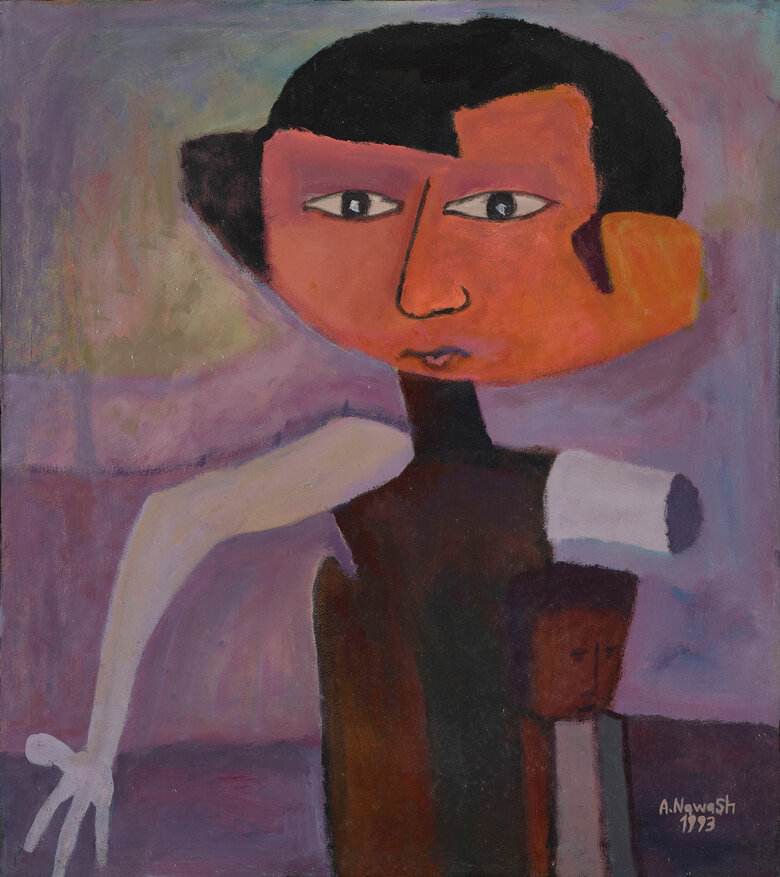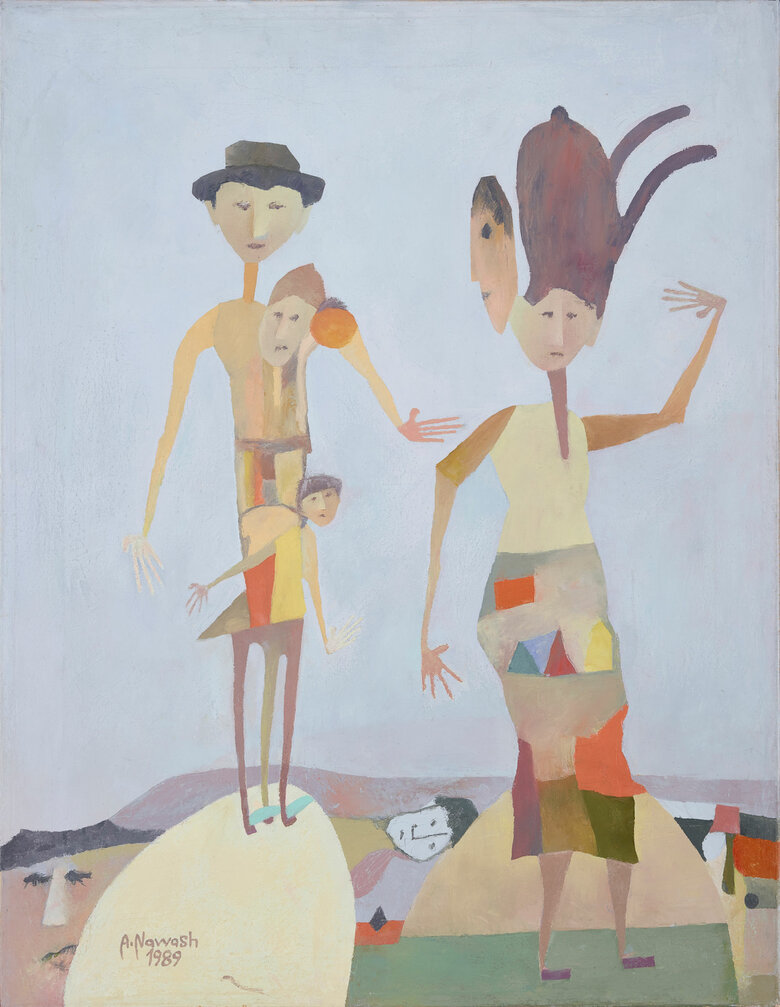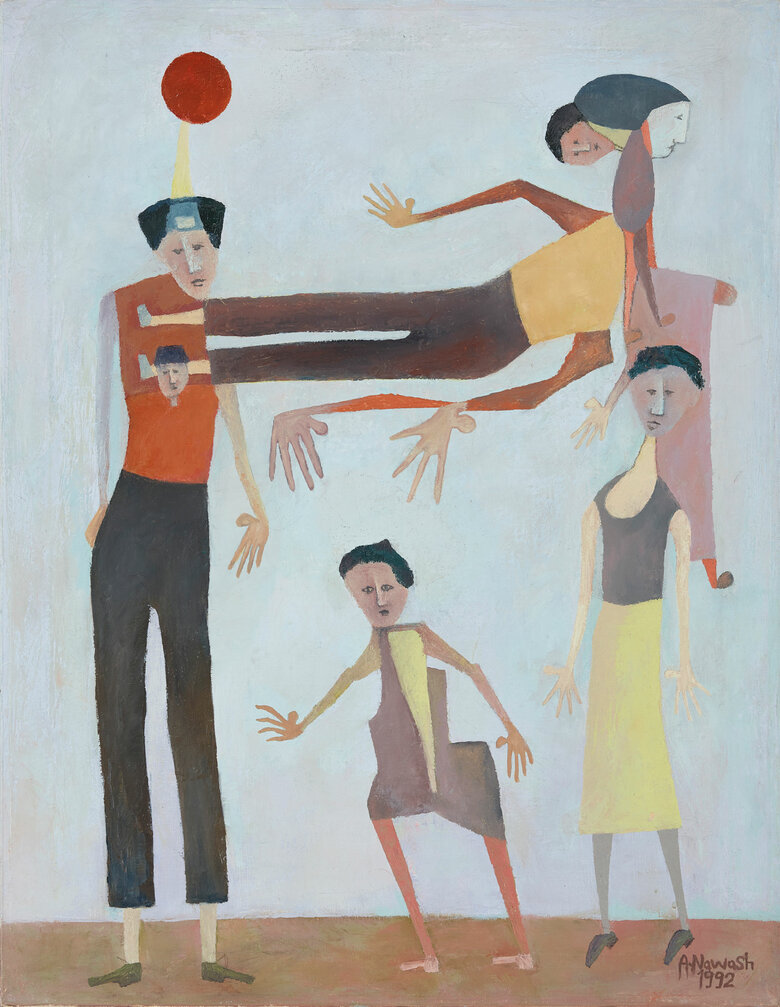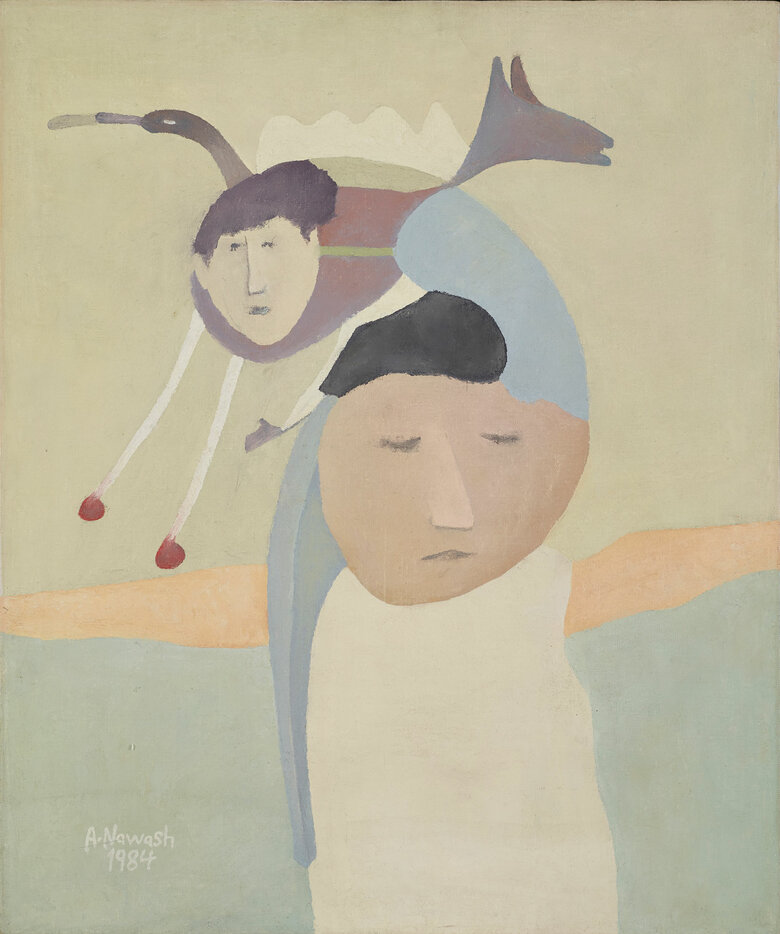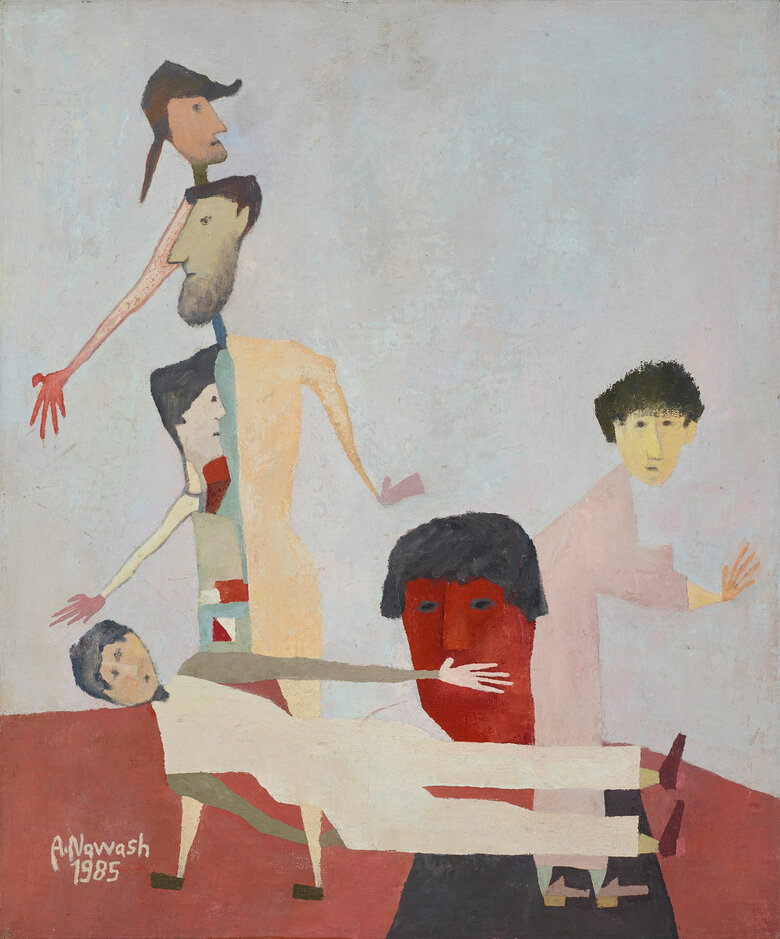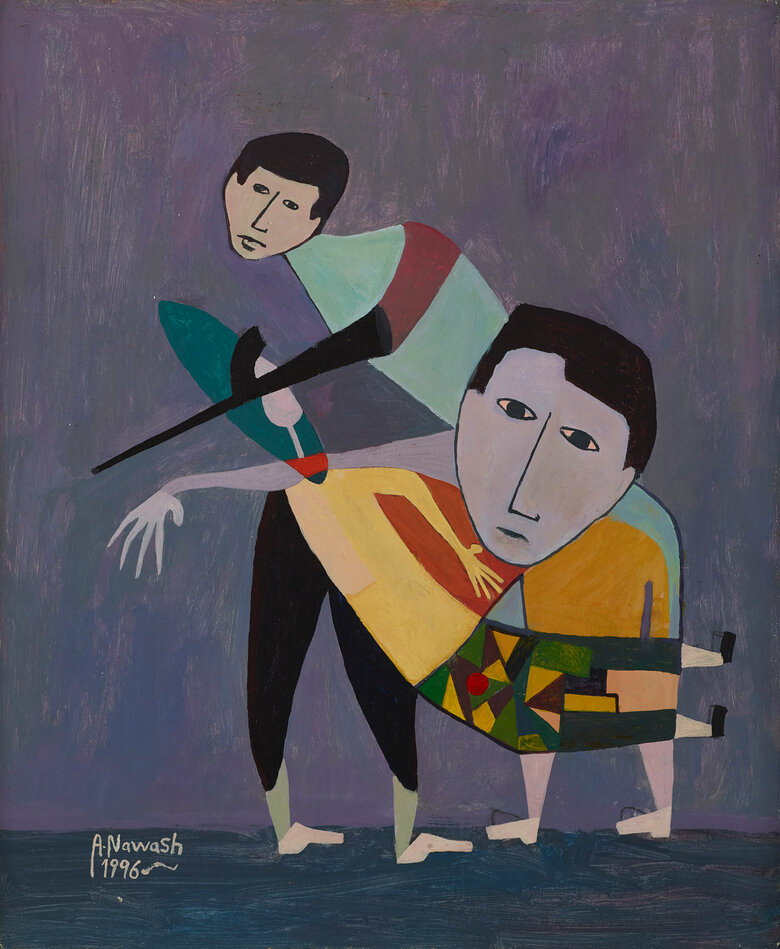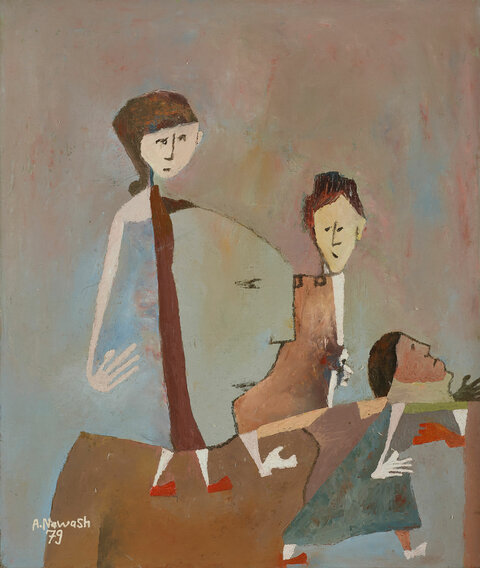Ahmad Nawash was born in Ain Karem, a Palestinian village just south of Jerusalem, in 1934. In 1964, he earned his BA with honors from the Academy of Fine Arts in Rome, and in 1970 received a...
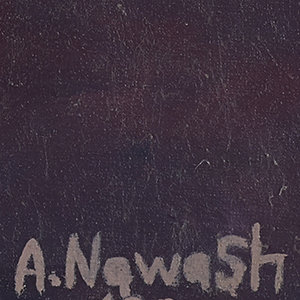

AHMAD NAWASH, Palestine (1934 - 2017)
Bio
Written by ALESSANDRA AMIN
Ahmad Nawash was born in Ain Karem, a Palestinian village just south of Jerusalem, in 1934. In 1964, he earned his BA with honors from the Academy of Fine Arts in Rome, and in 1970 received a certificate in lithography and zinc etching from the School of Fine Arts in Bordeaux, France. He continued to study these media in Paris from 1975 to 1977, and in Florence in 1980, where he also studied the restoration of oil paintings. A founding member of the Jordanian Plastic Artists Association, Nawash was an active and influential participant in various art scenes throughout the Middle East for over three decades.
Ahmad Nawash discovered his affinity for art as a young boy in Palestine. At the age of ten or twelve, he made the first work of art he recalls creating, which depicted Salah ad-Din, the medieval sultan who restored Jerusalem to Muslim rule. In 1948, when Nawash was fourteen years old, the Zionist occupation of Palestine forced him and his family out of their home in Ain Karem. Haunted by the massacre in nearby Deir Yassin, which had taken place only weeks earlier, the young artist fled with his parents, siblings, aunts, uncles, and cousins, first on foot and later as passengers in the back of a truck. Nawash’s family ultimately crossed the river to Jordan, settling first in Salt before relocating to Amman. Here, he began making art as a means of expressing himself and working through the trauma that had alienated him from his country.
The sudden, traumatic flight from Ain Karem would continue to haunt the artist well into his adulthood when Palestine became the dominant theme of his work. In a 2008 interview with Nadia el Issa, the artist stated that a genuine work of art “is the original fruit of its environment,” which, for him, was “Palestine and Jordan, together with the remainder of the Arab World and its miserable masses.” Nawash drew thematic inspiration from the social, political, and economic situations of the Arab World, including “the spectacle of constant bloodshed in Palestine and other Arab countries like Iraq” and “the increasingly widespread scenes of human dignity being trodden down on and abused.” The artist conceptualized his practice as the product of the relationship between his thoughts and emotions and the collective experiences of the world around him, and though they reflected on his environment, his works were rarely autobiographical. In fact, Nawash never inserted himself into his own work, and painted a family member only once, when he was grieving the untimely death of his son, Musa.
Although a prolific creator, Nawash’s style changed very little from his early days as a student in Europe through the end of his career as an internationally celebrated artist.
Most of the artist’s oeuvre comprises melancholy, dreamlike compositions, populated by human figures whose bodies do not obey natural laws of proportion or symmetry. These absurd beings float, unanchored, in planes of muted colors, existing in a visual field that seems to mark itself as a void rather than evoking any kind of tangible world. Though these characters seem constantly in motion, there is no narrative insofar as this motion does not suggest a direction or progression in space or time; instead, Nawash’s nightmarish figures seem to move without ever departing or arriving, trapped on a haunted path that leads nowhere. The stillness and silence of these compositions give them an especially eerie aura; as the late artist and critic Kamal Boullata put it, Nawash’s work seems “to reveal the hallucinations of one unable to scream.”
Nawash cited Paul Klee as his favorite artist and noted that he drew inspiration from the use of warm colors and transparency in his work. However, he attributed the bulk of his stylistic choices to natural emotional pulls as well as the influences of his environment. Feelings, the artist claimed, were the primary factor in shaping the form of his work, from line to proportions to color palette. His disjointed figures, for example, expressed the frustration and sense of loss he felt as a witness to various tragedies in the Arab world. Looking at Nawash’s oeuvre, it is clear that the primary emotion the artist sought to express was pain, but he nevertheless resisted the assumption that his work was nihilistic. “My works absolutely express hope for the future,” the artist protested in 2008. “While it is true that I depict the gloomy side of humanity and of the situation of the world today, how can I, an artist, change any of that except for through the creation of critical artworks that make harsh judgments of reality? I express my infinite hope for the future, then, through the continuation of my creative production.”
Ahmad Nawash died in Amman in May 2017.
Sources
Samia Halaby, “Ahmad Nawash, Painting in Exile.” Jerusalem Quarterly 76, 2018. https://www.palestine-studies.org/jq/fulltext/233121
“Ahmad Nawash – A Retrospective” exhibition catalog. Amman: Darat Al Funun, 2008.
CV
Selected Solo Exhibitions
2008
Ahmad Nawash – A Retrospective, Darat al Funun, Amman, Jordan
2002
4 Walls, Amman, Jordan
1999
City Hall, Greater Municipality of Amman, Amman, Jordan
1996
Jordanian Plastic Arts Association, Amman, Jordan
Galerie Bac Saint-Germain, Paris, France
1994
Darat al Funun, Amman, Jordan
1987
Alia Gallery, Amman, Jordan
1986
Yarmouk University, Irbid, Jordan
1984
The University of Jordan, Amman, Jordan
1982
Al Rasheed Hall, Baghdad, Iraq
1981
The Jordan National Gallery of Fine Arts, Amman, Jordan
1978
The Royal Cultural Center, Amman, Jordan
Salle des Pas Perdus, UNESCO, Paris, France
1977
The University of Jordan, Amman, Jordan
1975
The American Cultural Center, Amman, Jordan
1974
The University of Jordan, Amman, Jordan
1972
The University of Jordan, Amman, Jordan
1968
The Arab Cultural Center, Damascus, Syria
The American Cultural Center, Amman, Jordan
1967
Gulbenkian Hall, Baghdad, Iraq
1965-1999
The French Cultural Center, Amman, Jordan (17 exhibitions)
1965
Chamber of Commerce, Jerusalem, Palestine
Mount Scopus Hotel, Jerusalem, Palestine
The American Cultural Center, Amman, Jordan
1964
The British Council, Amman, Jordan
Studio Margutta 13, Rome, Italy
Selected Group Exhibitions
2024
Arab Presences: Modern Art And Decolonisation: Paris 1908-1988, Musée d'Art Moderne de Paris, Paris, France
2023
In Solidarity with Palestine, Darat al Funun, Amman, Jordan
Ce que la Palestine apporte au monde, Institut du monde arabe, Paris, France
2021
Postcolonial Ecologies, Darat al Funun, Amman, Jordan
2018
Pour un musée en Palestine "Nous aussi nous aimons l'art..", la collection du Musée d’art moderne et contemporain de Pal, Institute du Monde Arabe, Paris, France
2016
A Window On Contemporary Jordanian Art, Albareh Art Gallery, Adliya, Bahrain
2015
Rituals of Signs and Transitions (1975-1995),Darat al Funun, Jordan
2001
5thSharjah Biennale, Sharjah, UAE
2000
Seven Artists Meet,Sharjah Art Museum, Sharjah, UAE
Journey through the Contemporary Arts of the Arab World, Darat al Funun, Amman, Jordan
1999
Contemporary Jordanian Art Exhibition, Cologne, Germany
1997
Voyage en Jordanie, Salle Saint-Jean, Hôtel de Ville de Paris, Paris, France
1996
2ndEgyptian International Print Triennale, Cairo, Egypt
6thInternational Cairo Biennale, Cairo, Egypt
1993,1995
International Biennial of Prints and Drawing, Taipei Fine Arts Museum, Taipei, Taiwan
1985
Asilah Cultural Festival, Asilah, Morocco
1981
Kuwait Biennale
1971
Spring Exhibition, InterContinental Hotel, Amman, Jordan
Awards and Honors
1993
Appreciation Certificate, International Biennial of Prints and Drawing, Taipei Fine Arts Museum, Taipei, Taiwan
1990
State Recognition Prize, Jordan
1981
Gold Medal and Appreciation Certificate, Kuwait Biennale
Gold Shield and Appreciation Certificate, the Association of Arab Artists
Collections
The Khalid Shoman Foundation – Darat al Funun, Amman, Jordan
The Royal Palaces, Amman, Jordan
Jordan National Gallery of Fine Arts, Amman, Jordan
Dar al-Anda, Amman, Jordan
The Abdul Hameed Shoman Foundation, Amman, Jordan
Center for Popular Arts and Traditions, Tunisia
Pakistani National Council of Arts, Pakistan
Institut du Monde Arab, Paris, France
Ramzi and Saeda Dalloul Art Foundation, Beirut, Lebanon
Barjeel Art Foundation, Sharjah, UAE
Sharjah Art Museum, Sharjah, UAE
Press
AhmadNawash_Jordanian artists exhibit work at 7th Beirut Art Fair_Jordan Times_Press.pdf
Ahmad Nawash _ Darat al Funun.pdf
AhmadNawash_Art Dubai 2017_Booth M7_Modern Section_WADI Finan Art Gallery_Press.pdf
أحمد نعواش الرسام المختلف في فلسطينيته فاروق يوسف صحيفة العرب.pdf
Sahafi.pdf
وزير الثقافة ينعى الفنان أحمد نعواش.pdf
Al Arab p10.pdf
جريدة الغد.pdf
في غاليري بنك القاهرة عمان افتتح معرض رائد الفن الاردني احمد نعواش.pdf
الفنان احمد نعواش وفنه الاصيل.pdf
أحمد نعواش.. رحيل طفل عين كارم » صحيفة فنون الخليج.pdf
طباعة - أحمد نعواش_ من عين كارم إلى الطفولة الخالدة.pdf
طباعة - أحمد نعواش.. رحيل طفل عين كارم.pdf
اشتغالات تشكيلية للهاشمي ونعواش في «ارت دبي» - صحيفة الرأي.pdf
رحيل الفنان الفلسطيني أحمد نعواش.pdf
في تجربة الفنان احمد نعواش..حدود النص الفني وحافات الحلم - جريدة العراق اليوم.pdf
Al Arabi Al Jadid.pdf
سعورس _ الطفولة كما يستعيدها الرسام الفلسطيني أحمد نعواش.pdf
AHMAD NAWASH Artwork
Become a Member
Join us in our endless discovery of modern and contemporary Arab art
Become a Member
Get updates from DAF
Follow Artists
Save your favourite Artworks
Share your perspectives on Artworks
Be part of our community
It's Free!
We value your privacy
TermsCookiesPrivacy Policies
Become a Member
Get updates from DAF
Follow Artists
Save your favourite Artworks
Share your perspectives on Artworks
Be part of our community
It's Free!
We value your privacy
TermsCookiesPrivacy Policies
Become a Member
Get updates from DAF
Follow Artists
Save your favourite Artworks
Share your perspectives on Artworks
Be part of our community
It's Free!
We value your privacy
TermsCookiesPrivacy Policies
Welcome to the Dalloul Art Foundation
Thank you for joining our community
If you have entered your email to become a member of the Dalloul Art Foundation, please click the button below to confirm your email and agree to our Terms, Cookie & Privacy policies.
We value your privacy, see how
Become a Member
Get updates from DAF
Follow Artists
Save your favourite Artworks
Share your perspectives on Artworks
Be part of our community
It's Free!
We value your privacy
TermsCookiesPrivacy Policies



